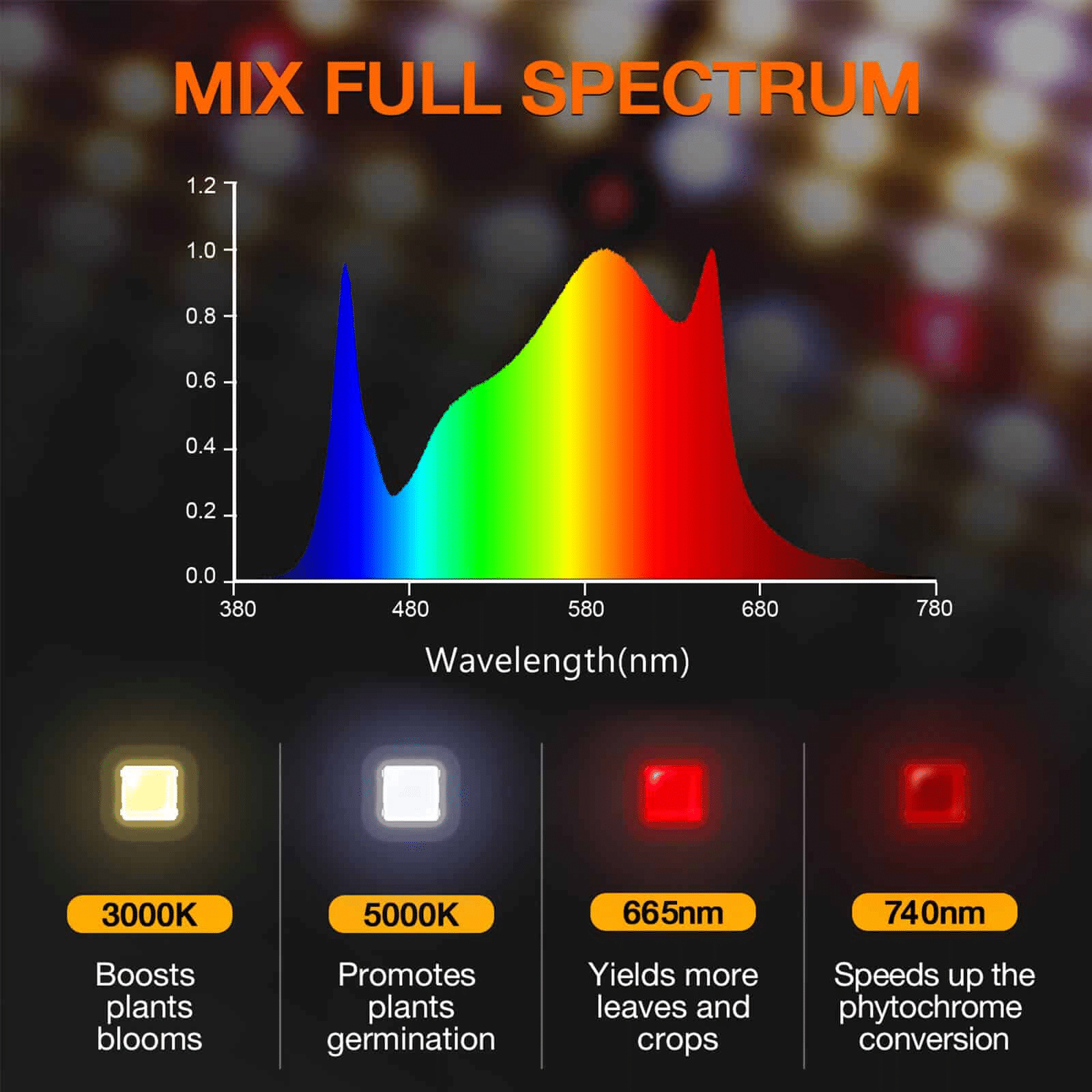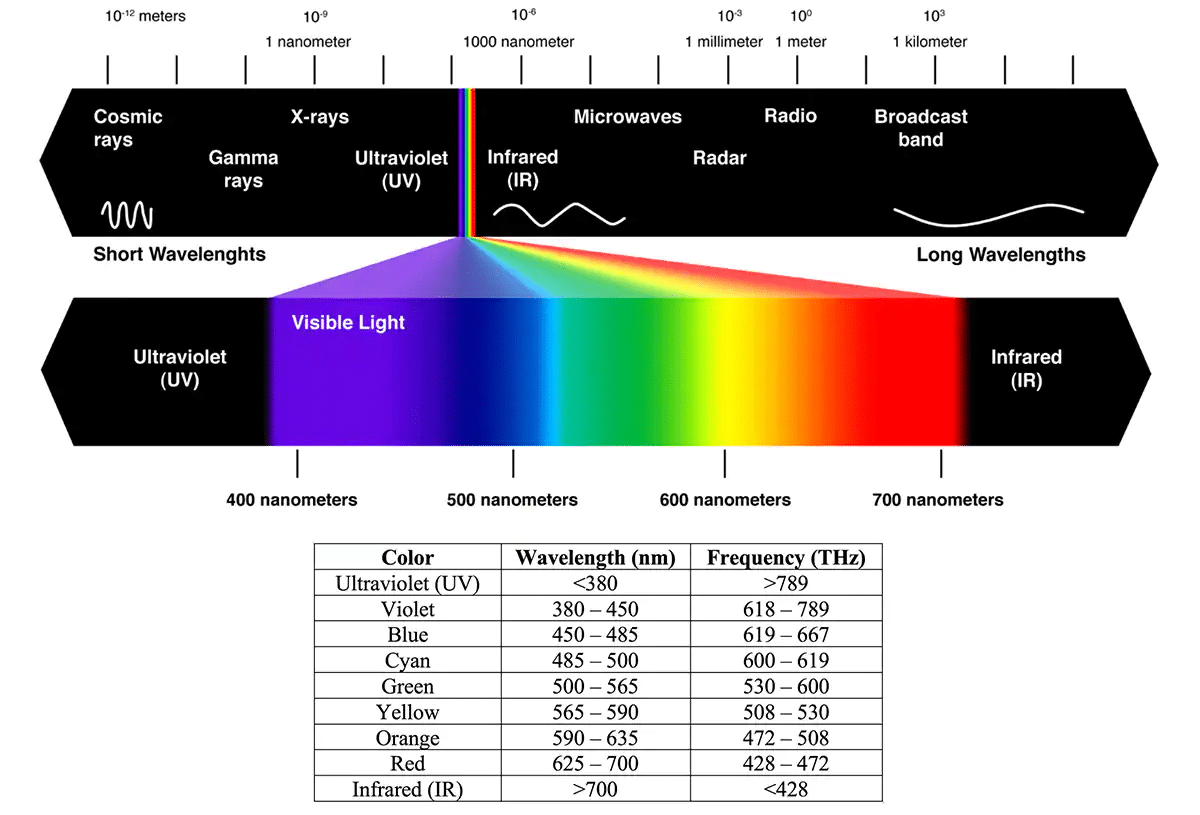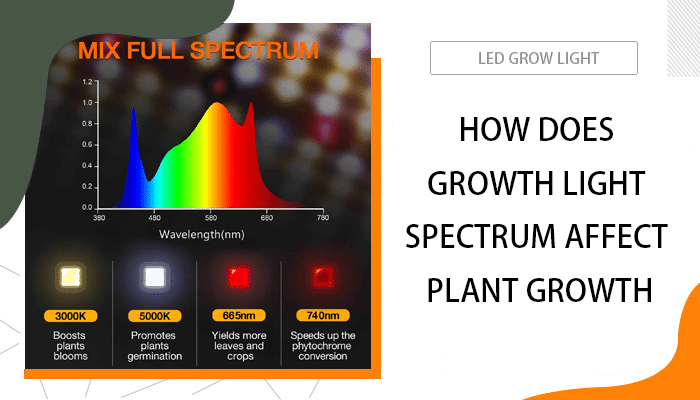How Does Growth Light Spectrum Affect Plant Growth
We all know plants require light to grow. The right growth light spectrum can significantly impact the growth, yield, and quality of your plants. To name one specific case, the blue light spectrum which ranges from 400- 500nm helps establish a healthy root and stem structure for your plants during the vegetative stage. In this article, we will explore different types of growth light spectrums, how they impact plant growth stages, and how to choose the right LED grow light for optimal light spectrum, as they provide a more efficient and cost-effective way of providing the right plant light spectrum.
What is Growth Light Spectrum?

First things first, it’s necessary to understand what is growth light spectrum exactly. Commonly used in indoor gardening, the growth light spectrum, measured in nanometers (nm), refers to the specific range of electromagnetic wavelengths of light produced by a light source that is capable of aiding and maintaining plant growth.
For optimal photosynthesis outcomes, plants need growth light spectrum in the PAR (photosynthetic active radiation) region of wavelengths (400nm-700nm). This range of wavelengths is essential for plant growth and development, as it provides the energy required for photosynthesis to occur.
6 Types of Growth Light Spectrum
There are multiple types of plant growth light spectrum, each with its unique benefits. Some of the most common types include red light, blue light, and full-spectrum light. By combining the differences among these light types and the needs of your plants, you’ll know which light spectrum for plant growth works the best for you.

Red Spectrum (660nm)
Red light spectrum encourages stem, leaf, and general vegetative growth. However, too much red light can cause plants to stretch and become spindly. A balanced combination of both red light and blue light is considered necessary to reduce any overstretching, like long internodes.
Blue Spectrum (400-500nm)
Blue light greatly contributes to growth and flowering, including stomatal opening, phototropism, and chloroplast movement. Moreover, it’s proven to improve the quality of certain types of plants.
Green Spectrum (500-600nm)
Green light has the least effect on plant growth and development. The reason is that green light is mostly reflected by plants, and only a small amount is absorbed, making it the least efficient growth light spectrum for photosynthesis. However, it can still contribute to plant growth by providing a balanced spectrum of light.
IR (700nm-1mm)
With longer wavelengths than all the above-mentioned plant light spectrum, infrared (IR) light is not some light you can directly see, but you can feel it for sure since IR light produces more heat. Some growers remain skeptical about IR light usage because they believe the heat will harm the growth. The truth is professional grow lights such as LED grow lights can emit the right infrared wavelengths that trigger plant growth and aid in photosynthesis.
UV Spectrum (280-315nm)
With the implementation of proper UV light, your plants are likely to produce specific substances that improve both flavor and crop quality. However, too much UV light can be harmful to plants, causing damage to their DNA and reducing their overall growth and yield.
In addition to the single light spectrum, full spectrum grow light includes all wavelengths of light, including red, blue, green, and other colors. Full spectrum light is pretty similar to natural sunlight and is the most ideal growth plant spectrum for plants, suitable for all stages of plant growth, from seedling to flowering.
Benefits of Using Growth Light Spectrum
The importance of growth light spectrum cannot be overstated. Without the right light spectrum for plant growth, the growth process can be stunted or even stopped altogether. Read on to know how each growth light spectrum benefits your plant development.
- Red Spectrum. Red light is the most important for photosynthesis, as chlorophyll a, the most common type, absorbs light best in the red area of the spectrum. It plays a vital role in the flowering and fruiting stages of plants by promoting stem elongation, leaf growth, and flowering. It also enhances the production of anthocyanins, which are pigments that give plants their red, purple, and blue colors.
- Blue Spectrum. Blue light is one of the best light spectrum for vegetative growth and foliage development. It stimulates chlorophyll production and enhances photosynthesis, resulting in healthier and more robust plants. This light spectrum also helps regulate plant growth, making it beneficial for maintaining compact and bushy plants.
- Green Spectrum. Green light spectrum is not as essential for plant growth as the above two light, but it still has some advantages. It penetrates deeper into the plant canopy and can improve light distribution, which can lead to more uniform growth.
- Full Spectrum. Full spectrum grow light provides a balance of all the necessary light spectrums for plant growth and development, making it versatile throughout the entire growth cycle, from seedling to harvest. Compared to combining multiple grow lights together, full spectrum lights can help increase yields and enhance plant quality while maintaining much lower energy costs.
- UV Spectrum. UV light spectrum does not assist plant growth directly, but it helps plants produce more secondary metabolites, say, flavonoids and terpenoids, which can improve plant flavor, aroma, and nutritional value. Meanwhile, it helps plants develop stronger stems and leaves.
How to Choose the Best Growth Light Spectrum?
Now you have a basic understanding of different types of plant growth light spectrum, along with their benefits. Possibly, you are wondering what color light is best for plant growth. To help you out, we’ve gathered some factors to consider.
Types of plants
While most plants require blue and red spectrum, with the blue light helping vegetative growth and the red light helping flowering and fruiting, the ratio can vary depending on the plant’s species. For instance, succulents require more red light for flowering and fruiting while a balanced ratio is more appropriate for leafy greens and herbs.
Growth stages
The lighting requirements keep changing as your plants step into different stages of growth.
- Seedling stage. A plant light spectrum with a higher ratio of blue light is ideal during this stage.
- Vegetative stage. Plants require a balanced ratio of blue and red light for optimal growth and development during this phase.
- Flowering stage. A light spectrum with a higher ratio of red light is ideal during this stage for more fruiting.
Growing environments
Is it indoor, greenhouse, outdoor, or hydroponic growing? Depending on the gardening environment, the answer to the best light spectrum for plant growth will also vary. To name one example, outdoor growing comes with natural sunlight that relies on the season, latitude, and weather conditions. Therefore, conditions like temperature and humidity should also be included when determining the best plant growth light spectrum.
Use LED Grow Light to Benefit Most from Growth Light Spectrum
By using light-emitting diodes (LEDs), a LED grow light aims to mimic the natural light spectrum required for your plant growth. It can be designed as a full-spectrum LED grow light which typically includes a mix of red, blue, green, and other colors to provide a balanced and comprehensive growth light spectrum for your plants. Therefore, LED grow lights can effectively promote growth in crops at specific stages of the growth cycle.
Additionally, compared with traditional grow lights, say, HPS grow lights, LED grow lights are way more energy-efficient and produces lower heat waste. Not to mention that they enjoy a longer lifespan. With all the benefits of using LED grow lights in plant growing, here comes the question, what is the best LED grow light?
Spider Farmer is one of the most renowned LED grow light manufacturers in the current market. The brand offers a wide range of full spectrum LED grow lights, all of which employ mostly the red and blue spectrum that is highly needed for your plant growth. Meanwhile, Spider Farmer LED grow lights guarantee higher yield, lower heat, and longer lifespan.
Unlike single-spectrum LED grow lights, an advanced model such as Spider Farmer SF1000 LED grow light is designed to ensure your plants get all the required light spectra from a single source. So, instead of buying multiple single spectrum LED grow lights, get a single yet multi-faceted full-spectrum LED grow light from Spider Farmer now.
Verdict on Growth Light Spectrum
Providing the optimal growth light spectrum can result in healthier, more robust plants with improved flavor and nutritional value. To choose the best plant light spectrum from all types, including red, blue, green light, etc., consider your plant type, growth stage, and the growing environment. Luckily for you, a full spectrum LED grow light is the most versatile option that caters to all lighting needs.





This was very helpful and will definitely help me to care for my Philodendron.
Great lesson on indoor lighting!
Thank you for an easy to understand description of the four spectrums of light on plants. Jesus bless you. LCRFuller